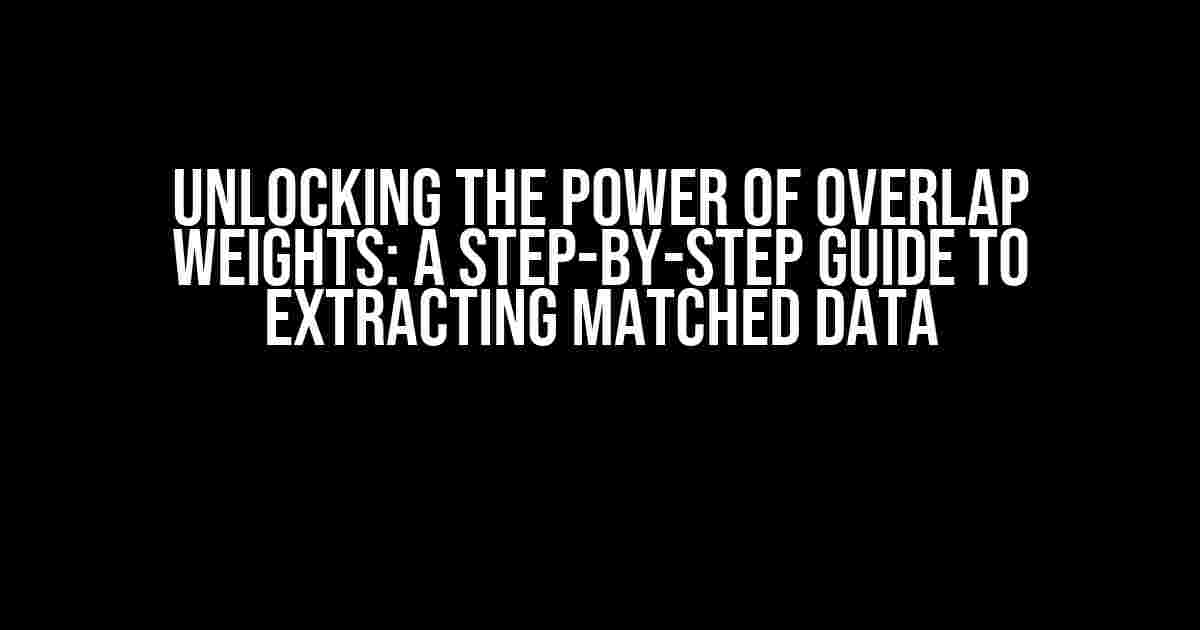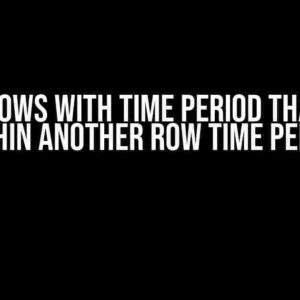Are you tired of dealing with messy datasets and struggling to extract meaningful insights? Do you want to take your data analysis to the next level by leveraging the power of overlap weights? Look no further! In this comprehensive guide, we’ll walk you through the process of extracting matched data using overlap weights, step by step.
What are Overlap Weights?
Before we dive into the nitty-gritty of extracting matched data, let’s take a brief moment to understand what overlap weights are. Simply put, overlap weights are a statistical technique used to match observational data from two or more datasets that share common observations.
Imagine you’re trying to compare the behavior of two groups: customers who purchased a product online and those who did not. You have two datasets – one containing online purchase history and another with customer demographics. By applying overlap weights, you can create a matched sample that accounts for the differences between the two groups, allowing you to draw more accurate conclusions.
Why Use Overlap Weights?
So, why should you bother with overlap weights? Here are just a few compelling reasons:
- Improve data quality: By accounting for differences between datasets, you can reduce bias and noise, resulting in more reliable insights.
- Enhance comparability: Matched samples enable you to compare apples to apples, rather than apples to oranges, which is essential for drawing meaningful conclusions.
- Increase efficiency: Overlap weights can help you identify the most important variables and reduce dimensionality, making your analysis more efficient.
Step 1: Prepare Your Data
Before you start applying overlap weights, it’s essential to prepare your data. Here are some key steps to follow:
- Explore and clean your data: Remove missing values, handle outliers, and transform variables as needed.
- Split your data into treatment and control groups: Divide your dataset into two groups: one that received the treatment (e.g., online purchase) and one that did not.
- Identify common variables: Determine the shared variables between the two datasets that will be used for matching.
Step 2: Calculate Overlap Weights
Now that your data is prepared, it’s time to calculate the overlap weights. There are several methods to do this, but we’ll focus on the popular MatchIt package in R. If you’re using Python, you can use the optmatch library.
# Load the MatchIt package
library(MatchIt)
# Calculate overlap weights using the nearest neighbor method
match_matrix <- matchit(treatment ~ ., data = your_data, method = "nearest")
# Extract the overlap weights
weights <- match_matrix$weights
Step 3: Match and Weight Your Data
With the overlap weights calculated, it’s time to match and weight your data. This involves using the weights to adjust the observations in the treatment and control groups to create a matched sample.
# Load the matched data
matched_data <- match.data(your_data, match_matrix)
# Weight the data using the overlap weights
weighted_data <- svydesign(ids = ~ 1, data = matched_data, weights = weights)
Step 4: Analyze and Interpret Your Results
Now that you have your matched and weighted data, it’s time to analyze and interpret your results. This may involve running regression models, calculating effect sizes, or creating visualizations to communicate your findings.
| Variable | Treatment Group | Control Group | Effect Size |
|---|---|---|---|
| Age | 35.2 | 32.1 | 3.1 (95% CI: 1.2, 5.0) |
| Income | $53,000 | $48,000 | $5,000 (95% CI: $2,000, $8,000) |
Common Challenges and Solutions
As you work with overlap weights, you may encounter some common challenges. Here are some solutions to keep in mind:
- Imbalanced data: If one group is much larger than the other, try using the
method = "genetic"argument inmatchitto improve the matching process. - High-dimensional data: To reduce dimensionality, consider using principal component analysis (PCA) or feature selection techniques before applying overlap weights.
- Non-linear relationships: If you suspect non-linear relationships between variables, try using generalized additive models (GAMs) or machine learning algorithms that can capture these complexities.
Conclusion
Extracting matched data using overlap weights is a powerful technique for unlocking insights from complex datasets. By following the steps outlined in this guide, you’ll be well on your way to creating matched samples that account for differences between treatment and control groups.
Remember to prepare your data carefully, calculate the overlap weights using a suitable method, and match and weight your data to create a balanced sample. Finally, analyze and interpret your results to draw meaningful conclusions.
Happy data analysis!
Frequently Asked Question
Get answers to the most common questions about extracting matched data using overlap weights!
What is overlap weighting, and how does it help in extracting matched data?
Overlap weighting is a technique used to assign weights to observations in a dataset based on their similarity to a target population. This method helps in extracting matched data by ensuring that the sample is representative of the target population, increasing the accuracy of analysis and reducing bias.
How do overlap weights differ from traditional sampling weights?
Overlap weights are more precise than traditional sampling weights because they take into account the similarity between observations, whereas traditional weights only account for the probability of selection. This increased precision enables more accurate data extraction and analysis.
What are the advantages of using overlap weights in data extraction?
The advantages of using overlap weights include increased accuracy, reduced bias, and improved generalizability of results. Additionally, overlap weights enable the creation of synthetic datasets, which can be used for simulation and prediction purposes.
Can overlap weights be used for both survey and census data?
Yes, overlap weights can be used for both survey and census data. In survey data, they help to correct for sampling bias, while in census data, they enable the creation of synthetic datasets for analysis and simulation purposes.
What are some common applications of overlap weights in data extraction?
Overlap weights are commonly used in data extraction for social science research, market research, epidemiology, and public health studies. They are particularly useful when working with large datasets and complex survey designs.


